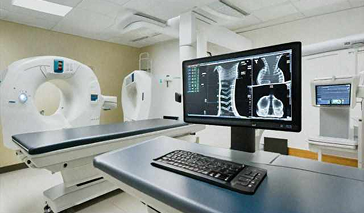
How to eliminate data re-entry with cloud PACS and RIS
Posted on July 18, 2019

We have already mentioned problems arising from double data entry. The main issues are time expenditures and high risk of human error, as well as the need for duplicating and synchronizing databases, which may be a costly affair. In one of our previous articles, we discussed how DICOM Modality Worklist can help to transfer patient information from a scheduling or dispatching system to a diagnostic machine. However, the connection between your scheduling service and diagnostic equipment is just a single link in your IT infrastructure. This time we will look at the situation through a broader lens and talk about how integrated healthcare solutions can help to eliminate the problem completely.
Let’s suppose you run a diagnostic imaging business, and you do it in a rather conservative way. Then your workflow is probably similar to the following.
First, you obtain patients’ information: demographics (age, sex, etc.), required studies, date and time of service, the referring doctor’s name, and then you pass this information to scheduling or dispatching software, where study orders are created. At this stage, you are likely to enter data manually, which is quite common.
Then you need to pass these orders to the diagnostic equipment of various modalities (X-ray, ultrasound, etc.). If you are using Modality Worklist, which is correctly configured, the data will be transmitted flawlessly. Otherwise, imaging technologists will have to re-enter all the patient information manually, which may lead to additional errors and affect the quality of their work (we should bear in mind that medical imaging is a very technologist-dependent industry).
When the studies are completed, images are sent to a PACS. There are several reasons for using cloud PACS, you might have read about them on our blog. The images include patient information for identification in the cloud PACS.
The next stage is reading, or image interpretation. The images are passed to a RIS (Radiology Information System), where the reading doctor analyzes them and creates a report on each study.
Having finalized the reports, the reading doctor sends them to a Health Information System (HIS). Depending on the degree of HIS integration into your IT infrastructure, the patient data may be sent automatically or entered manually once again (it has been already entered twice, so this is the third time).
After that, the reports can be received by the referring physician.
That’s what it looks like. You may have gotten used to this workflow, but even if all of your sonographers and technologists are flawless in data entry and never make mistakes, you would probably agree that this workflow lacks efficiency. You may hire the most skilled medical specialists, and still steadily lose revenue just because their skills are underused.
Your business may employ multiple standalone services and still suffer from mistakes arising from the data re-entry. The primary cause is the lack of integration of all these tools.
If you are thinking about streamlining your workflow, then full-featured software might be of interest to you. It may be designed as a module-based application. Such software applications put together all the stages of your workflow and offer multiple advantages – and minimizing data re-entries is just one of them. Once you have entered the patient’s information, it will be transmitted to the following stages or just stored in the system, so that you could quickly retrieve it at any time.
If your PACS server (or cloud PACS storage) is integrated with a HIS/RIS system, scheduling service, and appropriately configured diagnostic equipment, it is possible to transfer patient demographics directly from patient records. Then your sonographers and X-ray technologists will not have to re-enter any patient data on their machines.